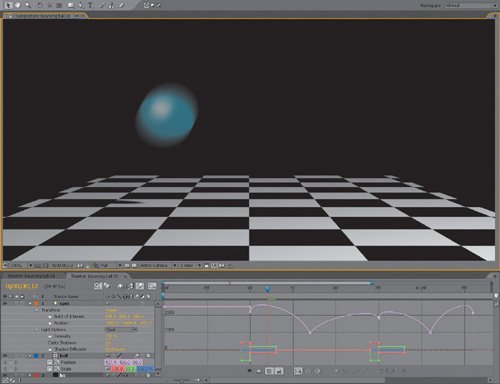The Timeline

I've been a long time coming, and I'll be a long time gone. You've got your whole life to do something, and that's not very long.
Ani DiFranco (American singer, songwriter, and guitarist)
The Timeline is After Effects' killer application. It is the reason above all others that After Effects is equally effective for motion graphics or visual effects work. Node-based compositors make it easy to see render order, but they can make coordinating the timing of events more difficult.
In 7.0, the Timeline has only become even better with the addition of the Graph Editor, a new user interface for editing multiple animation curves at once.
Notes
The Timeline even makes render order explicit if you know how to view it; 2D layers render beginning with the lowest in the stack and ending with the top. Properties of each layer (visible by twirling down) render in top-to-bottom order. Chapter 4, "Optimizing Your Projects," further explores the render pipeline.
With the Timeline as the center of your compositing process, you can always investigate how elements and timing relate. You could argue that render order is more significant than timing for visual effects work, but once you get the hang of managing the Timeline well, render order is no longer as much of an issue.
The Timeline panel is also a relatively user-friendly part of the application, albeit one packed with hidden powers. By unlocking those powers and mastering them, you can streamline your workflow a great deal, setting the stage for more advanced work.
One major source of hidden powers is the Timeline's set of shortcuts: A lot of what you can accomplish in the Timeline can be accomplished more efficiently and effectively using keyboard shortcuts and context menus. My feeling is that these are not extras to be learned once you're a veteran, but small productivity enhancers that you can learn gradually all the time, enhancers that collectively offer you a good deal of extra momentum and confidence as an After Effects artist.
Organization |
Section I. Working Foundations
The 7.0 Workflow
- The 7.0 Workflow
- Workspaces and Panels
- Making the Most of the UI
- Settings: Project, Footage, Composition
- Previews and OpenGL
- Effects & Presets
- Output: The Render Queue
- Study a Shot like an Effects Artist
The Timeline
- The Timeline
- Organization
- Animation Methods
- Keyframes and The Graph Editor
- Uber-mastery
- Transform Offsets
- Motion Blur
- Manipulating Time Itself
- In Conclusion
Selections: The Key to Compositing
- Selections: The Key to Compositing
- The Many Ways to Create Selections
- Compositing: Science and Nature
- Alpha Channels and Premultiplication
- Masks
- Combining Multiple Masks
- Putting Masks in Motion
- Blending Modes: The Real Deal
- Track Mattes
Optimizing Your Projects
- Optimizing Your Projects
- Navigating Multiple Compositions
- Precomposing and Nesting
- Adjustment and Guide Layers
- Understanding Rendering Order
- Optimizing After Effects
- Onward to Effects
Section II. Effects Compositing Essentials
Color Correction
Color Keying
- Color Keying
- Good Habits and Best Practices
- Linear Keyers and Hi-Con Mattes
- Blue-Screen and Green-Screen Keying
- Understanding and Optimizing Keylight
- Fixing Typical Problems
- Conclusion
Rotoscoping and Paint
- Rotoscoping and Paint
- Articulated Mattes
- Working Around Limitations
- Morphing
- Paint and Cloning
- Conclusion
Effective Motion Tracking
- Effective Motion Tracking
- The Essentials
- Optimizing Tracking Using 3D
- Extending a Track with Expressions
- Tracking for Rotoscoping
- Using 3D Tracking Data
- Conclusion
Virtual Cinematography
- Virtual Cinematography
- 5D: Pick Up the Camera
- Storytelling and the Camera
- Camera Blur
- The Role of Grain
- Film and Video Looks
- Conclusion
Expressions
- Expressions
- Logic and Grammar
- Muting Keyframes
- Linking Animation Data
- Looping Animations
- Smoothing and Destabilizing
- Offsetting Layers and Time
- Conditionals and Triggers
- Tell Me More
Film, HDR, and 32 Bit Compositing
- Film, HDR, and 32 Bit Compositing
- Details
- Film 101
- Dynamic Range
- Cineon Log Space
- Video Gamma Space
- Battle of the Color Spaces
- Floating Point
- 32 Bits per Channel
- Conclusion
Section III. Creative Explorations
Working with Light
- Working with Light
- Light Source and Direction
- Creating a Look with Color
- Backlighting, Flares, Light Volume
- Shadows and Reflected Light
- HDR Lighting
- Conclusion
Climate: Air, Water, Smoke, Clouds
- Climate: Air, Water, Smoke, Clouds
- Particulate Matter
- Sky Replacement
- The Fog, Smoke, or Mist Rolls In
- Billowing Smoke
- Wind
- Water
- Conclusion
Pyrotechnics: Fire, Explosions, Energy Phenomena
- Pyrotechnics: Fire, Explosions, Energy Phenomena
- Firearms
- Sci-Fi Weaponry
- Heat Distortion
- Fire
- Explosions
- In a Blaze of Glory
Learning to See
Index
EAN: 2147483647
Pages: 157
